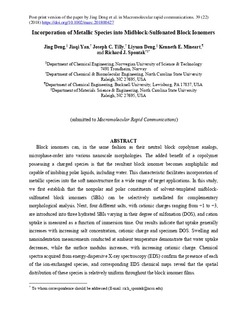Incorporation of Metallic Species into Midblock‐Sulfonated Block Ionomers
Journal article, Peer reviewed
Accepted version

Åpne
Permanent lenke
http://hdl.handle.net/11250/2592648Utgivelsesdato
2018Metadata
Vis full innførselSamlinger
Sammendrag
Block ionomers can, in the same fashion as their neutral block copolymer analogs, microphase‐order into various nanoscale morphologies. The added benefit of a copolymer possessing a charged species is that the resultant block ionomer becomes amphiphilic and capable of imbibing polar liquids, including water. This characteristic facilitates incorporation of metallic species into the soft nanostructure for a wide range of target applications. In this study, the nonpolar and polar constituents of solvent‐templated midblock‐sulfonated block ionomers (SBIs) are first selectively metallated for complementary morphological analysis. Next, four different salts, with cationic charges ranging from +1 to +3, are introduced into three hydrated SBIs varying in their degree of sulfonation (DOS), and cation uptake is measured as a function of immersion time. These results indicate that uptake generally increases with increasing salt concentration, cationic charge, and specimen DOS. Swelling and nanoindentation measurements conducted at ambient temperature demonstrate that water uptake decreases, while the surface modulus increases, with increasing cationic charge. Chemical spectra acquired from energy‐dispersive X‐ray spectroscopy (EDS) confirm the presence of each of the ion‐exchanged species, and corresponding EDS chemical maps reveal that the spatial distribution of these species is relatively uniform throughout the block ionomer films.